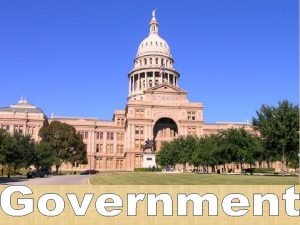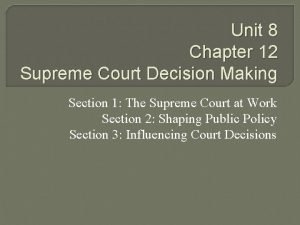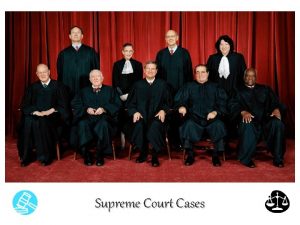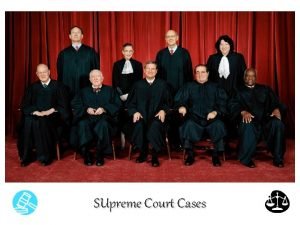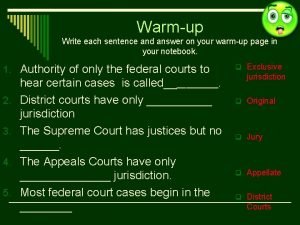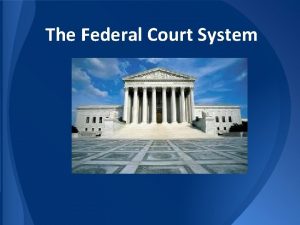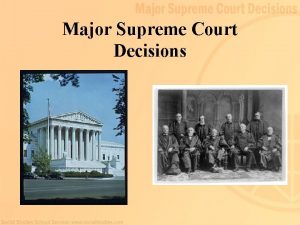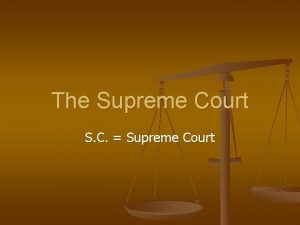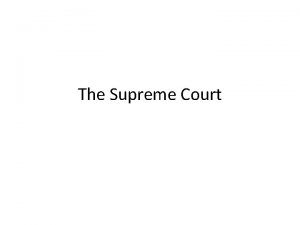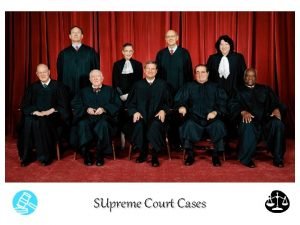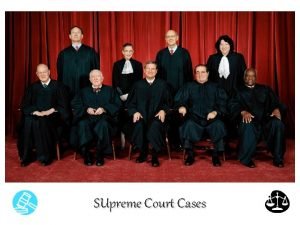Major Supreme Court Decisions Major Supreme Court Decisions










- Slides: 10

Major Supreme Court Decisions

Major Supreme Court Decisions 2

Constitutional Rights • Declaration of Independence introduced the fundamental rights provided by the Constitution • Right to life, liberty, and the pursuit of happiness • Framers saw the government as unfinished and believed that rights would evolve over time • Who possessed these rights— were they absolute, unlimited, and guaranteed in all cases? 3

Constitutional Rights (continued) • Constitution is a “living document” -- adaptable to the times • Supreme Court defines the meaning of the Constitution • Boundaries within the government and between government and the people help safeguard the people’s rights • The court’s rulings often reflect the times and are subject to change 4

The Supreme Court: The Early Years • Origins in the Constitution • Judiciary Act of 1789 • Early years saw little participation, activity, or interest • First major case was quickly overturned • Hearing cases in circuit courts (“riding circuit”) both physically demanding and ethically questionable John Jay, the first chief justice of the Supreme Court 5

The Supreme Court: The Early Years (continued) • Supreme Court viewed as “least dangerous branch” of government • Major political parties: Federalists and Democratic. Republicans • Each party wanted to take the country in a different direction • 1801: President Adams appoints John Marshall Chief Justice Thomas Jefferson John Adams 6

The Supreme Court: The Early Years (continued) • Partisanship dominated politics • To extend Federalist influence, President Adams appointed “midnight judges” • Marbury v. Madison (1803) • The Supreme Court is an appellate court Federalists and Democratic-Republicans brawl in the House of Representatives, 1798 7

The Supreme Court: The Early Years (continued) • Marshall’s ruling originated the doctrine of judicial review • Only the court has the power to declare acts of Congress and the president unconstitutional John Marshall 8

The Importance of Judicial Review • Confirms the Framers’ intention to create three separate and independent branches of government • Judicial review established the court’s unique ability to interpret the Constitution • The interpretation may change with the times, as the court makes decisions on a case-by-case basis 9

Discussion Questions 1. Explain the statement, “The Constitution is a living document. ” What is the Supreme Court’s role as it relates to the Constitution? 2. What were some of the problems the Supreme Court faced during the first ten years of its existence? 3. Describe the differing visions the Federalists and the Democratic-Republicans had for the country, as well as the criticisms each party had of the other. 10
 Is there a basketball court above the supreme court
Is there a basketball court above the supreme court Meaning of poster making
Meaning of poster making Have supreme court
Have supreme court Vocabulary activity 12 supreme court decision making
Vocabulary activity 12 supreme court decision making Supreme court cases graphic organizer answers
Supreme court cases graphic organizer answers Insular cases apush
Insular cases apush The u.s. supreme court works chiefly as a(n)
The u.s. supreme court works chiefly as a(n) How cases reach the supreme court worksheet answers
How cases reach the supreme court worksheet answers Victorian court hierarchy
Victorian court hierarchy Supreme court justice system
Supreme court justice system Which of these best summarizes the monroe doctrine?
Which of these best summarizes the monroe doctrine?


